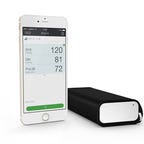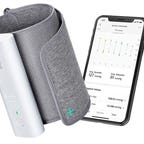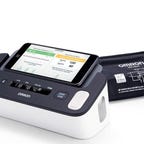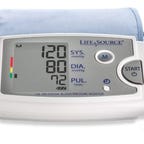

Best overall at-home blood pressure monitor
QardioArm Blood Pressure Monitor

Runner-up at-home blood pressure monitor
Withings BPM Connect Wi-Fi Smart Blood Pressure Monitor

Best blood pressure monitor with EKG
Omron Complete Wireless Upper Arm Blood Pressure Monitor + EKG

Best blood pressure monitor for larger arms
LifeSource Upper Arm Blood Pressure Monitor With Extra Large Cuff
Editor's note, June 15, 2024: Product testing and reviews for this list were done in 2019 by CNET contributor Amanda Capritto. We'll update this list with new testing results when available.
It’s important to pay attention to your body and health stats, especially as you get older. If you’re looking for easy ways to monitor your health at home, smartwatches and other wearable devices are a great place to start. If you have more serious concerns like hypertension or high blood pressure then you should consider picking up a blood pressure monitor. Regularly monitoring your blood pressure can help to make sure you’re on the right track with your personal health... or show you where you might need to make changes. For high blood pressure concerns, being able to get blood pressure readings at home may give comfort as you'll be able to track them as often as you'd like. This saves you from having to go to a professional every time you want a reading by selecting from the many simplified home blood pressure monitors now available.
By following the American Heart Association's tips for measuring blood pressure and choosing the right device, you can keep track of your numbers at home to share with your doctor as part of your blood pressure management plan or stay on top of your blood pressure before it becomes something that requires more management.
While all offer a variety of features at a range of prices, each of the best blood pressure monitor options below has been independently validated against one or more sets of AHA-recognized standards to track accurate blood pressure readings. In other words, no matter which form of blood pressure monitoring you choose, your heart will thank you for the accurate measurement. Beyond taking accurate readings, some of these devices can also help you keep track of your heart rate and notify you if you have an irregular heartbeat.
If you've been diagnosed with high blood pressure or you take medication to manage your blood pressure, be sure to check with your doctor to see if they have a specific recommendation on which device is best for your specific needs and lifestyle.
The QardioArm Blood Pressure Monitor is one of those "Apple of X" things -- this is the Apple of at-home blood pressure cuffs.
Not that "cool-looking" should be your priority when shopping for a blood pressure machine, but it certainly makes home monitoring feel like less of a chore than it otherwise might be when you're working on preventing hypertension or managing heart disease.
Here are the other great features: This cuff is comfortable. The cuff size was a fit for a (kind of lanky) arm, with no gaps between the skin and the fabric. The readings were consistent and accurate and the setup was almost unbelievably easy. This thing was out of the box, on the arm and connected to a phone in about 2 minutes, and the first blood pressure reading was done about 30 seconds after that.
Your whole family can use it. This digital blood pressure monitor pairs wirelessly with up to eight phones or tablets at any given time. (Let's see a manual blood pressure monitor do that.) Each time you use the digital monitor, the QardioArm averages three readings, monitors and detects an irregular heartbeat, and stores all your measurements and notes in Qardio's HIPAA-compliant cloud.
View and share your data in the Qardio App, where you can also set goals and reminders, and sync your data with Apple Health on iPhone or Google Fit/Samsung Health on Android devices.
Photo Gallery 1/1
The Withings BPM Connect feels and looks just as trendy as the QardioArm, and it provides a consistent and accurate result. It was a tough call between the QardioArm and the Withings BPM Connect because they're both great and similar products.
In the end, the Withings BPM Connect was the runner-up only because its sign-up process was more cumbersome. To compare, it took about 2 minutes to get completely set up with the QardioArm, whereas it took about 15 minutes with the Withings BPM Connect.
That's not bad in the overall realm of things, but it was noticeable.
As for the upper arm cuff fit, comfort and ease of use, the Withings BPM Connect holds its own. The app is also a breeze once you're in, and it has unlimited storage for your BP measurement needs (although the device will remember up to eight readings in between syncs). You can also set up multiple user profiles in the Withings Health Mate app.
The Omron Complete Wireless Upper Arm Blood Pressure Monitor with EKG was the first FDA-approved combination EKG-blood pressure device in the US. Omron produced the product in partnership with AliveCor, which powers many FDA-approved consumer electrocardiogram (EKG or ECG) devices.
Worth mentioning is that this blood pressure monitor gave the most consistent readings throughout the entire testing process. It measures so much more than just blood pressure. In addition to the essentials -- systolic and diastolic blood pressure -- this Omron model measures your pulse, atrial fibrillation, tachycardia, bradycardia and sinus rhythm simultaneously.
If you need a seamless way to measure two or more of those metrics, this upper-arm monitor is a top choice. The Omron app interface is simple, and it can store unlimited data. The cuff is comfortable and flexible, making it easy to get a good fit, which helps with accuracy.
The monitor itself is a little bulkier than other models on this list but probably worth it for people who need all those other measurements in one place. It comes in a nice carrying case that you can use for traveling.
If you have larger upper arms, you know that not all arm monitors fit comfortably making blood pressure management and monitoring a huge pain. Enter the LifeSource Upper Arm Blood Pressure Monitor With Extra Large Cuff. The name says it all. This blood pressure cuff accommodates an arm circumference of over 23 inches.
There didn't seem to be a lot of information about this one online, and there were some questionable reviews from buyers. LifeSource is a brand of A&D Medical, a medical equipment brand that's been manufacturing at-home consumer devices for close to 50 years and has all of its products clinically validated by third parties. This cuff easily made it into our corral of products to test.
This blood pressure cuff is indeed massive, and it would never work for someone with tiny arms, so our testing couldn't speak to the device's accuracy. Despite being tested on a small arm, it did produce consistent readings. Although the blood pressure level readings were wrong in our tests, they were consistently wrong. That gave hope that this extra-large cuff is indeed accurate for the people it actually fits.
Several more at-home blood pressure monitors also had some great features but didn't quite match up to the ones above. They're worth checking out if you're in the market for an at-home blood pressure monitor, although the above products proved the best in our tests, you might find a unique combo of characteristics that's best for you.
The blood pressure monitors listed in this article were tested at home in 2019. They were used with proper fitting, typical of how you'd use an arm cuff and monitor to get your blood pressure reading.
Because getting an accurate blood pressure reading or numbers depends on a couple of crucial factors, this review focused on how the cuff fit and how consistent the measurements were.
If you have high blood pressure or hypertension, the first thing you should do is check with your doctor or primary care provider to see what their recommendation is for you. Home monitoring and staying on top of your prescribed medication is important for people with high blood pressure, but it's also important to keep in mind that it doesn't replace regular doctor visits, according to the AHA.
Consider the following factors when you're looking for an at-home device:
- Size of your arm: What's a good fit, cuff-wise, for a larger arm might not be the best fit for a smaller arm, and vice versa.
- Other heart conditions: Some devices may provide other health metrics, like pulse rate, or detect other health conditions, like irregular heartbeat.
- Place of measurement: Right now the AHA doesn't recommend using a finger or wrist blood pressure monitor to measure blood pressure, because the readings may be less reliable than ones that come from the arm.
- Clinical validation: This means the device has gone through testing that satisfies medical standards.
How do I actually use a blood pressure monitor?



























